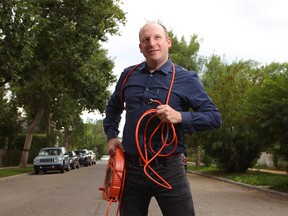
Albertans reacted quickly and cut their power use after an emergency alert was issued last month — but would they also do so to save some money?
The idea is something Affordability and Utilities Minister Nathan Neudorf says he’s examining as the government prepares to reform the province’s power system in the coming weeks.
“It’s going to be a big part of our plan going forward, (it’s) the concept and understanding of demand-side management, where we don’t just have to continue to build and build and build our system larger,” Neudorf said in a recent interview.
“There are lots of things that we can do to be more optimized on the demand side . . . that’s going to be a very important factor.
“It also helps with our public engagement. I think we got a bit of a boost that way from Jan. 13 — the Saturday night in the dark — of what we can do on the demand side to really have significant impacts.”
Several studies are underway or have just wrapped up as Alberta looks to overhaul the province’s power system, including a review on approving renewable energy developments and the broader structure of the deregulated electricity market.
The idea of demand-side management — such as trying to encourage consumers to lower consumption at certain times — and energy efficiency are ways to reduce the load on the grid.
With the increased electrification of the economy and the expected growth of EVs — the federal government has mandated all new cars and pickup trucks sold by 2035 be zero-emissions — there will be a need for more power.
Is there also a way to use technology and planning to reduce the requirement for massive spending on additional infrastructure and generation?
-
 Power fail: How Alberta’s unique energy-only market contributed to cold-snap gridlock
Power fail: How Alberta’s unique energy-only market contributed to cold-snap gridlock -
 Alberta’s utilities minister defends ‘energy-only’ power market amid blackout scare
Alberta’s utilities minister defends ‘energy-only’ power market amid blackout scare -
 Perfect storm led to threat of Alberta electricity blackout
Perfect storm led to threat of Alberta electricity blackout -
 Are Calgary’s office towers the behemoth energy users they appear to be?
Are Calgary’s office towers the behemoth energy users they appear to be?
Some provinces and jurisdictions have introduced “time-of-use” pricing, offering preferential electricity rates to consumers using power during off-peak periods.
For example, the British Columbia Utilities Commission approved in December the option of “time-of-use” rates for residential customers with BC Hydro. It’s expected to be available as early as June.
Under the plan, customers who voluntarily sign up will get a five-cent per kilowatt-hour (kWh) discount for electricity used overnight between 11 p.m. and 7 a.m., when demand is low. They will face a five-cent per kWh charge for consumption during the hours of 4 p.m. to 9 p.m.
The idea is to encourage customers to shift electricity consumption to times of the day when there is more capacity available.
In Alberta, Neudorf said the sudden reduction of power use on Jan. 13 during a deep freeze — about 200 MW of demand was cut shortly after the emergency alert went out — shows the ability of consumers to respond.
“If we’re going to empower the demand side of the equation, then let’s empower them — and that will also, in my opinion, require a little bit of fiscal incentive,” he said.
“And this is pretty basic. Time-of-use pricing is the easiest way to offer that incentive.”
Neudorf noted about 40 per cent of provincial consumers already have smart meters installed.
In Calgary, Enmax has been installing advanced meters in new homes since 2018 and upgrading broken or expired units; about half of the meters in the city in total have been upgraded.
Planning is also imperative to keep costs low for the entire system.
A recent report prepared for the Alberta Utilities Commission (AUC) indicated the cost of reaching net-zero emissions in the distribution systems — distribution lines carry power from the transmission system to consumers — could reach $3 billion by 2050.
However, up to $800 million of that can be cut through system optimization, it found.
The drop in costs is mainly because of an assumed 35 per cent reduction in peak charging hours by optimizing consumption for electric vehicles, according to AUC’s comments on the report.
Last year, results of an EV smart charging pilot program, released by Enmax Power, found incentives are likely needed to encourage consumers on when to charge their vehicles. It noted about 70 per cent of EV owners responded to a 3.5 cent per kWh reward to charge during non-peak times between 10 p.m. and 6 a.m.
University of Calgary economist Blake Shaffer, an electricity industry expert, said giving consumers options and incentives on when to charge their EVs makes sense.
“We’re finding that consumers are more than happy to do it because they’re getting a savings,” he said.
“To me, it’s imperative that we move forward with demand side management . . . The technology to make it easy for people has been relatively limited, but now that’s all changing.”

Jesse Row, executive director of Alberta Energy Efficiency Alliance, said time-of-use pricing is one way to help shift demand and influence when people use electricity.
Yet, energy efficiency measures and demand response — such as signals being sent to equipment to turn down when not in use — are other approaches to reduce consumption peaks and “get the best reliability at the lowest costs possible,” he said.
NDP MLA Nagwan Al-Guneid said demand side management should be part of a suite of solutions for Alberta, but the province also needs to allow low-cost supply to enter the market by removing the pause on approving new renewable projects.
“This is a government that is showing a pattern of a lack of planning. We knew supply was limited,” Al-Guneid said Friday.
“You can’t hope and rely on the consumer goodwill here to reduce their consumption. Hope is not strategy here.”
Neudorf said the various reports on Alberta’s power sector will be examined by the UCP government and future direction is expected to be announced sometime next month.
Chris Varcoe is a Calgary Herald columnist.
You can read more of the news on source




